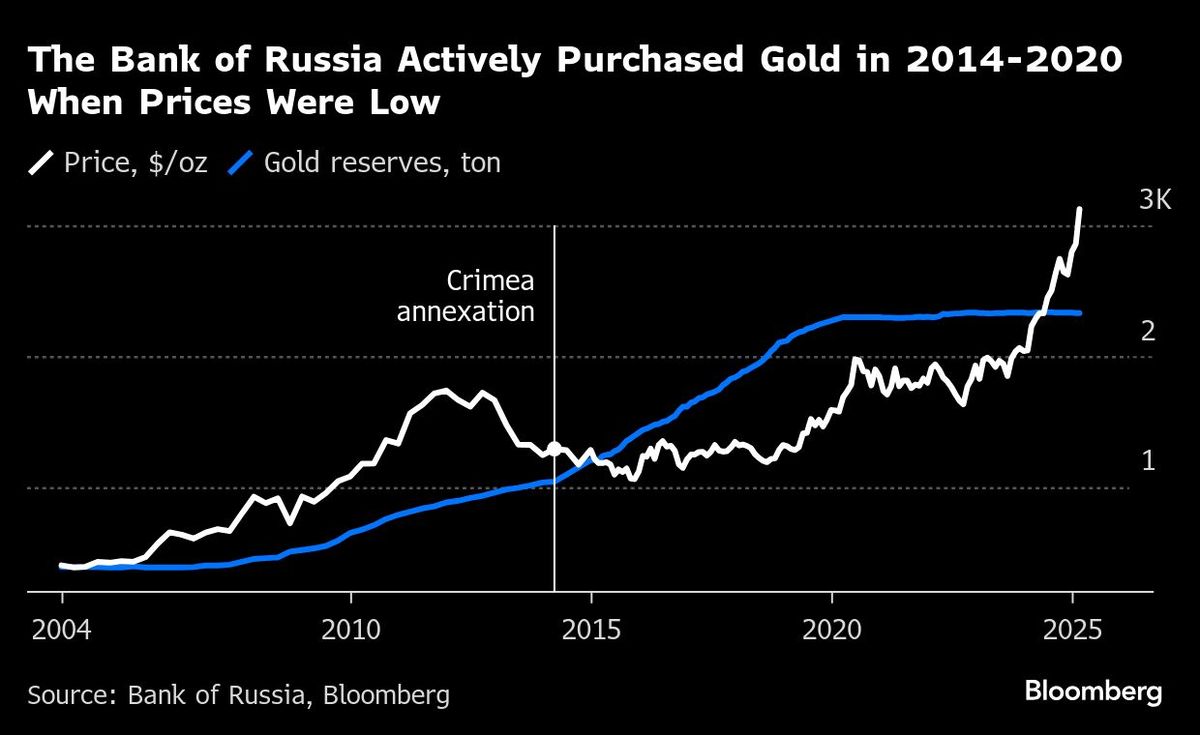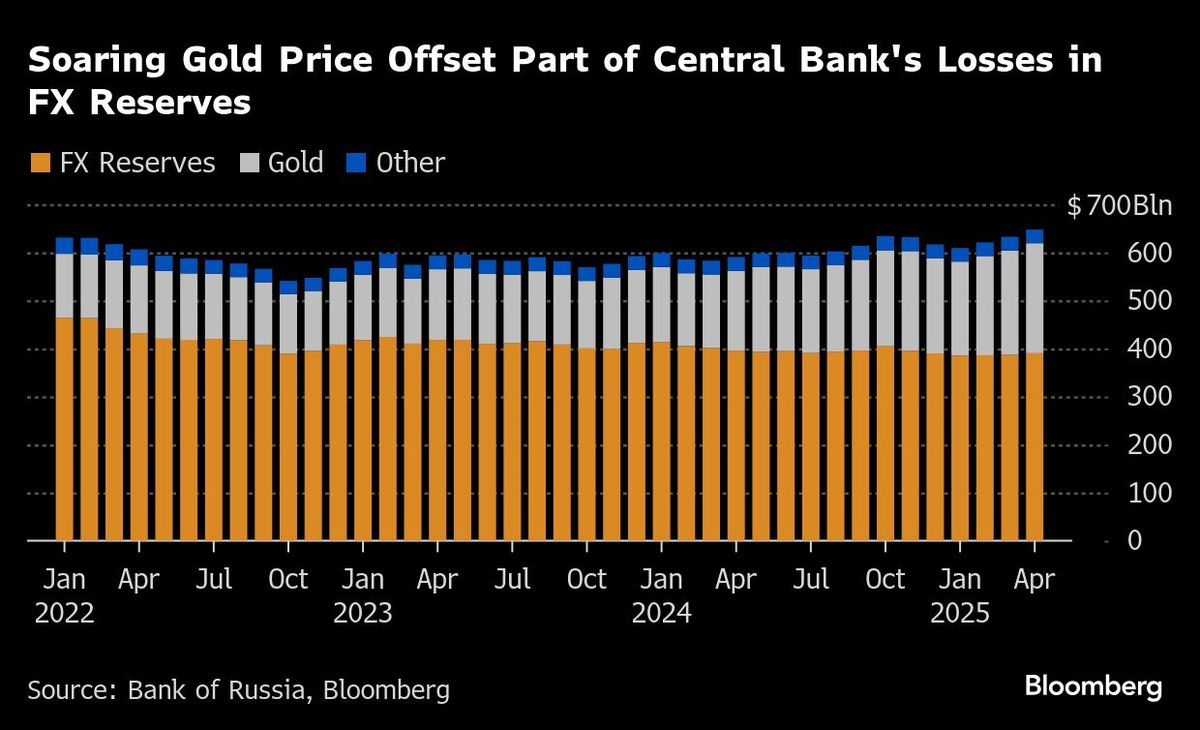
According to the Bank of Russia data, the value of its gold reserves has surged by 72%, or US$96 billion (RM425.71 billion), since the beginning of 2022.
(April 7): Russia is reaping the benefit of a pre-war gold-buying spree that’s helped offset roughly a third of the frozen assets in its rainy-day fund.
The value of Russia’s gold reserves has surged by 72%, or US$96 billion (RM425.71 billion), since the beginning of 2022, according to central bank data. The physical amount of gold in the Bank of Russia’s coffers hasn’t changed significantly over the last three years, remaining at around 75 million ounces, data shows.
The fate of the country’s reserves that were frozen abroad as punishment for Russian President Vladimir Putin’s 2022 invasion of Ukraine remains uncertain. The European Union (EU) hasn’t ruled out using some of the funds to help Kyiv to fight against Russia or to finance reconstruction after the conflict ends.
In the worst-case scenario, where none of the frozen assets are recovered, the increase in the value of Russia’s gold would compensate for about a third of the potential losses. Should US President Donald Trump’s efforts to end the war lead to the unfreezing of all of the remaining reserves, the Kremlin would sit on a financial cushion the likes of which it has never had before.
“Gold is relatively illiquid compared to other traditional reserve assets such as US Treasuries or European debt securities,” said Tatiana Orlova, an economist at Oxford Economics. But high current global demand for gold could make it easier than usual for the central bank to sell a relatively large amount of it in the case of a balance-of-payments crisis, she said.
The central bank began its splurge in 2014, following Russia’s illegal annexation of Crimea, which triggered western sanctions and its expulsion from the Group of Eight countries. Between 2014 and 2020, a time when the gold price ranged from about US$1,100 to US$1,500 per ounce, it increased its reserves of the precious metal by 40 million ounces.
Since then the metal’s price has more than doubled, pushing Russia’s total international reserves close to a historical high of nearly US$650 billion, as of April 1.
The Bank of Russia is currently among the top five largest holders of gold among central banks, based on data from the World Gold Council, with US$229 billion worth of the metal in reserves.
Following the 2022 invasion of Ukraine, the US and its allies imposed a new wave of sweeping sanctions on key sectors of the economy and state entities, including freezing some of the central bank’s reserves. According to Bloomberg calculations based on the latest available data about the structure of Russia’s foreign currency reserves, blocked funds may amount to about US$322 billion.
According to that data, Russia held half of its reserves in dollar, euro and pound sterling assets. The rest was invested in yuan and gold, which remain accessible for emergency use. Since the start of the war, the central bank has ceased publishing data on the specific composition of its foreign exchange reserves.
“Accumulating a gold pile was a hedge against geopolitical shocks — it worked. The Bank of Russia’s approach to gold purchases addressed three different goals: (i) diversifying international reserve assets away from the risks of reserve currency issuing countries, (ii) boosting domestic local currency liquidity by exchanging physical gold for rubles, and (iii) providing a source of stable demand for local gold miners. The increase in the value of gold holdings proves the diversification and hedging value of gold reserves,” says Alex Isakov of Bloomberg Economics.
Gold hit a record US$3,167.84 an ounce on Thursday before paring some of those gains as growing concern over escalating trade and geopolitical tensions, fuelled by US President Donald Trump’s recent tariffs, sends traders to havens. Bullion just completed its best quarter in decades, delivering a compounded return of about 27% since the end of 2022 when its bull run began — well above what most other assets have provided over the same period.
Unless confronted with a severe crisis, the rise in the price of gold is unlikely to spur Russia’s central bank to begin selling, given its limited options to reallocate funds amid sanctions.
The Bank of Russia recognised its “limited” opportunities to invest in financial instruments of other countries due to “risks inherent in their economies, currencies and financial markets” in its annual report published in March.
“There is no need to spend reserves now,” said Oleg Kuzmin, head of research at Renaissance Capital. “The Bank of Russia has enough liquidity in yuan in case of any shocks.”
Uploaded by Felyx Teoh
- All Malaysia-based carriers failed to meet international punctuality target in January — Mavcom
- Trump floats possible exceptions to 10% baseline tariff, says 'something positive to come' in trade fight with China
- US bond yields and gold rise, dollar down as turbulent week comes to an end
- EU races to expand €2 tril trade network as US links sour
- Navigating Trump’s tariff endgame
- Asean to act as one on US tariffs — PM
- Trump planning order to enable critical metals stockpiling — FT
- Kelantan gets 30% increase in allocation, proof that govt fair to all, says PM
- Cahya Mata Sarawak plans second clinker line to double cement output
- Trump's trade team chases 90 deals in 90 days. Experts say good luck with that


